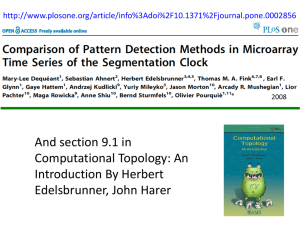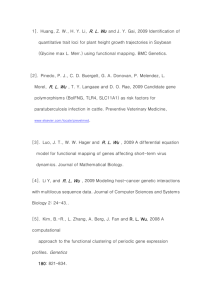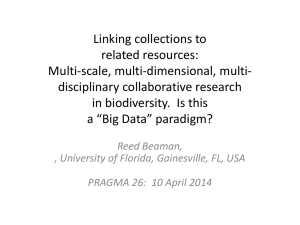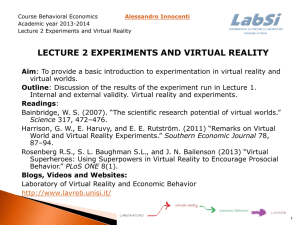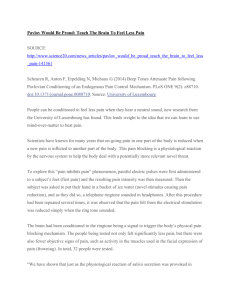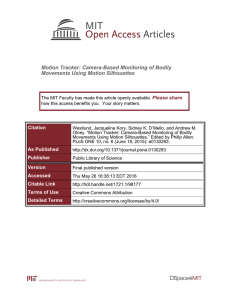slides
advertisement
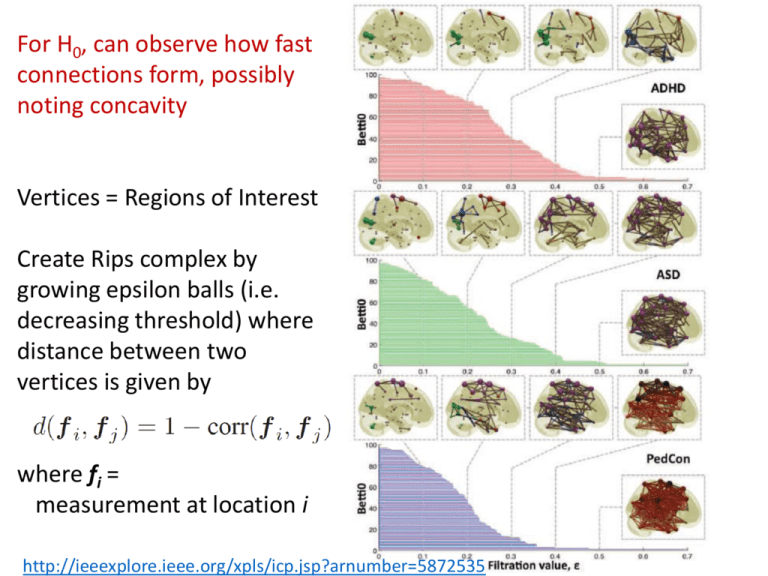
For H0, can observe how fast
connections form, possibly
noting concavity
Vertices = Regions of Interest
Create Rips complex by
growing epsilon balls (i.e.
decreasing threshold) where
distance between two
vertices is given by
where fi =
measurement at location i
http://ieeexplore.ieee.org/xpls/icp.jsp?arnumber=5872535
Betti numbers provide a signature of the underlying topology.
Use (b0, b1, b2, …) for classification, where bi = rank of Hi
Singh G et al. J Vis 2008;8:11
©2008 by Association for Research in Vision and Ophthalmology
Estimation of topological structure in driven and spontaneous conditions.
•Record voltages at points in time at each electrode.
•Spike train: lists of firing times for a neuron
• obtained via spike sorting –i.e. signal processing.
•Data = an array of N spike trains.
•Compared spontaneous (eyes occluded) to evoked (via
movie clips).
•10 second segments broken into 50 ms bins
•Transistion between states about 80ms
•The 5 neurons with the highest firing rate in each ten
second window were chosen
•For each bin, create a vector in R5 corresponding to the
number of firings of each of the 5 neurons.
•200 bins = 200 data points in R5.
•Used 35 landmark points.
•20-30minutes of data = many data sets
•Control: shuffled data 52700 times.
Singh G et al. J Vis 2008;8:11
©2008 by Association for Research in Vision and Ophthalmology
Combine your analysis with other tools
http://www.plosone.org/article/info%3Adoi%2F10.1371%2Fjournal.pone.0002856
2008
And section 9.1 in
Computational Topology: An
Introduction By Herbert
Edelsbrunner, John Harer
Goal: To determine what genes are involved in a
particular periodic pathway
Application: segmentation clock of mouse embryo.
• 1 somite develops about every 2 hours
What genes are involved in somite development?
Persistence:
For each of 7549 genes, create
fk: S1 R, k = 1, …, 7549
fk (time point i) = amount of RNA at time point i for
gene k
Not period 2:
Not period 2:
Not period 2:
Not period 2:
Period 2
Persistence:
For each of 7549 genes, create
fk: S1 R, k = 1, …, 7549
fk (time point i) = amount of RNA at time point i for
gene k
Figure 8. Function g(x) for the expression pattern of Axin2.
Dequéant M-L, Ahnert S, Edelsbrunner H, Fink TMA, et al. (2008) Comparison of Pattern Detection Methods in Microarray Time Series of the
Segmentation Clock. PLoS ONE 3(8): e2856. doi:10.1371/journal.pone.0002856
http://www.plosone.org/article/info:doi/10.1371/journal.pone.0002856
Not period 2:
Data from:
During the formation of each somite, Lfng is expressed in the PSM
as a wave that sweeps across the tissue in a posterior-to-anterior
direction (1). Therefore, by visually comparing the anteroposterior
position of the Lfng expression stripes in the PSM in stained
embryos, it is possible to define an approximate chronological order
of the embryos along the segmentation clock oscillation cycle (3, 4).
We collected PSM samples from 40 mouse embryos ranging from 19
to 23 somites and used their Lfng expression patterns as a proxy to
select 17 samples covering an entire oscillation cycle.
Indeed, due to technical issues, the right PSM samples of the time
series were dissected from mouse embryos belonging to five
consecutive somite cycles, and they were ordered based on their
phase of Lfng expression pattern (revealed by in situ hybridization
on the left PSM of each dissected mouse embryo) to reconstitute a
unique oscillation cycle [5].
Fig. 2. Identification of cyclic genes based on the PSM microarray time series.
M Dequéant et al. Science 2006;314:1595-1598
Published by AAAS
http://www.ebi.ac.uk/arrayexpress/
accession number E-TABM-163
Persistence:
For each of 7549 genes, create
fk: S1 R, k = 1, …, 7549
fk (time point i) = amount of RNA at time point i for
gene k
17 time points 17 equally space time points
microarry expression of gene k at time i ranked
order of microarry expression of gene k at time i
Ex: (0.41, 0.63, 0.11, 0.23, 0.59) (3, 5, 1, 2, 4).
fk (time point i) = RNA intensity at time point i for gene k.
p(fk) = replace RNA intensity with rank order.
g(xi) =[ p(fk)(xi) – 1] / (17 – 1), for i = 1, …, 17.
g(x) obtained by linear interpolation for x ≠ xi for some i.
Note: 0 ≤ g(x) ≤ 1
Figure 8. Function g(x) for the expression pattern of Axin2.
Dequéant M-L, Ahnert S, Edelsbrunner H, Fink TMA, et al. (2008) Comparison of Pattern Detection Methods in Microarray Time Series of the
Segmentation Clock. PLoS ONE 3(8): e2856. doi:10.1371/journal.pone.0002856
http://www.plosone.org/article/info:doi/10.1371/journal.pone.0002856
Not period 2:
17 time points 17 equally space time points
microarry expression of gene k at time i ranked
order of microarry expression of gene k at time i
Ex: (0.41, 0.63, 0.11, 0.23, 0.59) (3, 5, 1, 2, 4).
http://journals.plos.org/plosone/article?id=10.1371/journal.pone.0002856
http://journals.plos.org/plosone/article?id=10.1371/journal.pone.0002856
L=LombScargle
analysis;
P=Phase
consistency
A=Address
reduction;
C= Cyclohedron
test;
S=Stable
persistence
The
benchmark
cyclic genes
in bold
were
identified
independently from
the
microarray
analysis
Figure 1. Identification of benchmark cyclic genes in the top 300 probe set lists of the five methods.
Dequéant M-L, Ahnert S, Edelsbrunner H, Fink TMA, et al. (2008) Comparison of Pattern Detection Methods in Microarray Time Series of the
Segmentation Clock. PLoS ONE 3(8): e2856. doi:10.1371/journal.pone.0002856
http://www.plosone.org/article/info:doi/10.1371/journal.pone.0002856
Figure 2. Comparison of the intersection of the top 300 ranked probe sets from the five methods.
Dequéant M-L, Ahnert S, Edelsbrunner H, Fink TMA, et al. (2008) Comparison of Pattern Detection Methods in Microarray Time Series of the
Segmentation Clock. PLoS ONE 3(8): e2856. doi:10.1371/journal.pone.0002856
http://www.plosone.org/article/info:doi/10.1371/journal.pone.0002856
Figure 3. Clustering analysis of the top 300 ranked probe sets from the five methods.
Dequéant ML, Ahnert S, Edelsbrunner H, Fink TMA, Glynn EF, et al. (2008) Comparison of Pattern Detection Methods in Microarray Time Series
of the Segmentation Clock. PLoS ONE 3(8): e2856. doi:10.1371/journal.pone.0002856
http://127.0.0.1:8081/plosone/article?id=info:doi/10.1371/journal.pone.0002856
Table 1. Composition of the Wnt Clusters of the Five Methods.
Dequéant ML, Ahnert S, Edelsbrunner H, Fink TMA, Glynn EF, et al. (2008) Comparison of Pattern Detection Methods in Microarray Time Series
of the Segmentation Clock. PLoS ONE 3(8): e2856. doi:10.1371/journal.pone.0002856
http://127.0.0.1:8081/plosone/article?id=info:doi/10.1371/journal.pone.0002856
Persistent homology results are stable:
Add noise to data does not change barcodes significantly.
http://www.ams.org/publications/authors/books/postpub/mbk-69
Persistent homology
results
stable:
Figure 8. Function
g(x) forare
the expression
pattern of Axin2.
Add noise to data does not change barcodes significantly.
Dequéant M-L, Ahnert S, Edelsbrunner H, Fink TMA, et al. (2008) Comparison of Pattern Detection Methods in Microarray Time Series of the
Segmentation Clock. PLoS ONE 3(8): e2856. doi:10.1371/journal.pone.0002856
http://www.plosone.org/article/info:doi/10.1371/journal.pone.0002856
|| (x1,…,xn) – (y1,…,yn) ||∞ = max{|x1 – y1|,…,|xn - yn|}
Given sets X, Y and bijection g: X Y,
Bottleneck Distance: dB(X, Y) = inf sup || x – g(x) ||∞
g
x
(Wasserstein distance). The p-th Wasserstein
distance between two persistence diagrams,
d1 and d2, is defined as
where g ranges over all bijections from d1 to d2.
Probability measures on the space of
persistence
diagrams
Yuriy Mileyko1, Sayan Mukherjee2 and John Harer1
Persistent homology results are stable:
Add noise to data does not change barcodes significantly.

